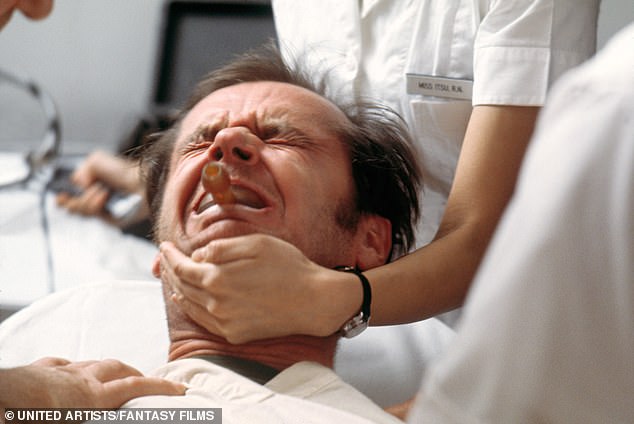Ministers are facing calls to order an inquiry into a ‘primitive’ treatment for depression that involves passing electric currents through the brain.
Electro-convulsive therapy (ECT) has been used for almost a century to treat an array of psychiatric disorders including mania, catatonia and schizophrenia.
But critics say evidence supporting its use is poor, while its potential side effects including memory loss, sight problems and trauma can be debilitating.
The effects of ECT were famously portrayed in the 1975 film One Flew Over the Cuckoo’s Nest, starring Jack Nicholson – although medics say the gruesome fictional account bears no relation to the reality of ECT.
Ministers are facing calls to order an inquiry into a ‘primitive’ electro-convulsive therapy (ECT) for depression, which were famously portrayed in the 1975 film One Flew Over the Cuckoo’s Nest, starring Jack Nicholson (pictured)
More than 40 opponents of the treatment, including doctors and patients, have written to Health Secretary Matt Hancock demanding a review of procedure, which is still given to thousands of NHS patients every year.
The moves comes just days after a Government-commissioned review of medical devices found thousands of women and children were harmed because problems with pelvic mesh implants, a pregnancy test and an epilepsy drug were overlooked.
The ECT campaigners claim their concerns have been similarly dismissed because most sufferers are older women.
Last night one of the letter’s organisers, Dr Sue Cunliffe, from Worcestershire, said: ‘People wouldn’t believe that something as primitive as ECT is still being used in modern psychiatry. It should have been banned decades ago.’
Dr Cunliffe claimed she was forced to abandon her career as a paediatrician because of brain damage caused by 21 ECT sessions in a year – almost double the recommended number.
‘I was left with an inability to recognise faces, my hands shook uncontrollably and I couldn’t walk in a straight line,’ she said.
Her speech was slurred and she struggled to read or even remember words. She said it also deeply affected her memory.
Another signatory, clinical psychologist Dr Lucy Johnstone, from Bristol, said: ‘ECT recipients among us have been left with severe psychological trauma and lifelong impairments to their cognitive functioning.’
At its peak in the 1950s and 1960s, about 50,000 people were given ECT annually for myriad mental health problems.

Dr Sue Cunliffe, from Worcestershire, claimed she was forced to abandon her career as a paediatrician because of brain damage caused by 21 ECT sessions in a year – almost double the recommended number (stock image)
That number has since fallen to about 2,000 each year, most with severe depression.
Last month a review of ECT trials by psychologists at Harvard Medical School in the US and the University of East London (UEL) found it was ineffective for treating depression.
‘Sham’ treatments, where patients thought they were undergoing ECT when, in fact, no electricity was actually passed through their brains, were just as effective.
Dr John Read of UEL, also a signatory of the letter to Mr Hancock, said the evidence on which the use of ECT rested was ‘of the lowest quality I’ve seen in my 40-year career’.
However, the Royal College of Psychiatrists continues to back its use, saying it can be ‘life-saving’ for patients with severe depression.
It cites data from 2016-17 which ‘showed that 43 per cent of patients were “much improved” and 30 per cent “very much improved” after ECT’. Just over one per cent were ‘minimally worse, much worse or very much worse’.
Dr Rupert McShane, chairman of the College’s Committee on ECT and Related Treatments, said: ‘The close monitoring of potential side effects is a routine part of practice and allows clinicians to adjust treatment accordingly.’
